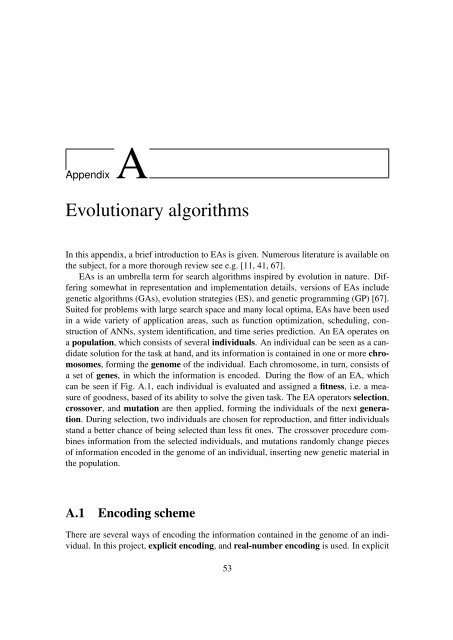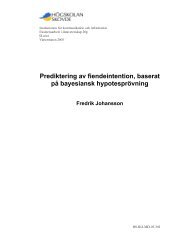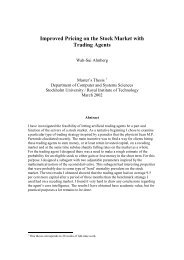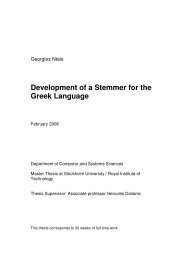Modeling Hydra Behavior Using Methods Founded in Behavior-Based Robotics
Modeling Hydra Behavior Using Methods Founded in ... - SAIS
Modeling Hydra Behavior Using Methods Founded in ... - SAIS
Create successful ePaper yourself
Turn your PDF publications into a flip-book with our unique Google optimized e-Paper software.
Appendix AEvolutionary algorithmsIn this appendix, a brief <strong>in</strong>troduction to EAs is given. Numerous literature is available onthe subject, for a more thorough review see e.g. [11, 41, 67].EAs is an umbrella term for search algorithms <strong>in</strong>spired by evolution <strong>in</strong> nature. Differ<strong>in</strong>gsomewhat <strong>in</strong> representation and implementation details, versions of EAs <strong>in</strong>cludegenetic algorithms (GAs), evolution strategies (ES), and genetic programm<strong>in</strong>g (GP) [67].Suited for problems with large search space and many local optima, EAs have been used<strong>in</strong> a wide variety of application areas, such as function optimization, schedul<strong>in</strong>g, constructionof ANNs, system identification, and time series prediction. An EA operates ona population, which consists of several <strong>in</strong>dividuals. An <strong>in</strong>dividual can be seen as a candidatesolution for the task at hand, and its <strong>in</strong>formation is conta<strong>in</strong>ed <strong>in</strong> one or more chromosomes,form<strong>in</strong>g the genome of the <strong>in</strong>dividual. Each chromosome, <strong>in</strong> turn, consists ofa set of genes, <strong>in</strong> which the <strong>in</strong>formation is encoded. Dur<strong>in</strong>g the flow of an EA, whichcan be seen if Fig. A.1, each <strong>in</strong>dividual is evaluated and assigned a fitness, i.e. a measureof goodness, based of its ability to solve the given task. The EA operators selection,crossover, and mutation are then applied, form<strong>in</strong>g the <strong>in</strong>dividuals of the next generation.Dur<strong>in</strong>g selection, two <strong>in</strong>dividuals are chosen for reproduction, and fitter <strong>in</strong>dividualsstand a better chance of be<strong>in</strong>g selected than less fit ones. The crossover procedure comb<strong>in</strong>es<strong>in</strong>formation from the selected <strong>in</strong>dividuals, and mutations randomly change piecesof <strong>in</strong>formation encoded <strong>in</strong> the genome of an <strong>in</strong>dividual, <strong>in</strong>sert<strong>in</strong>g new genetic material <strong>in</strong>the population.A.1 Encod<strong>in</strong>g schemeThere are several ways of encod<strong>in</strong>g the <strong>in</strong>formation conta<strong>in</strong>ed <strong>in</strong> the genome of an <strong>in</strong>dividual.In this project, explicit encod<strong>in</strong>g, and real-number encod<strong>in</strong>g is used. In explicit53





